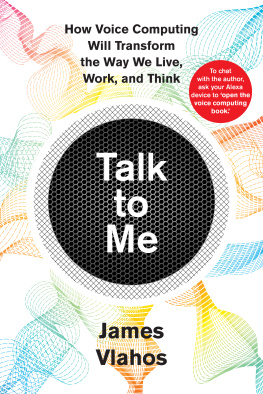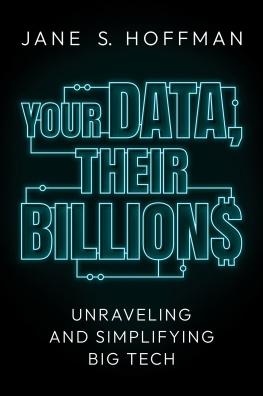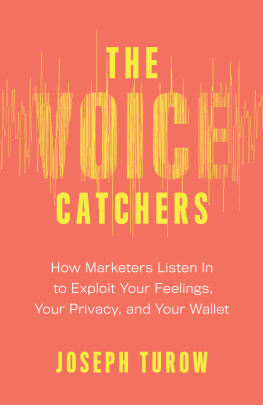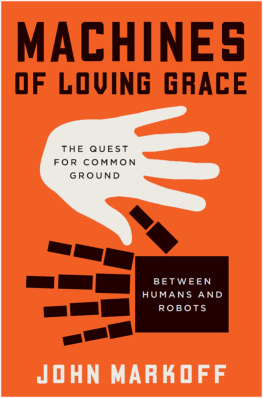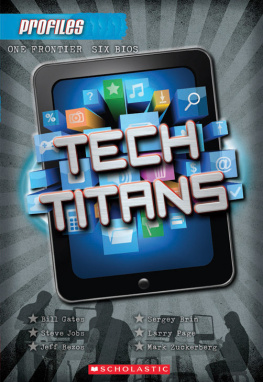Copyright 2019 by James Vlahos
All rights reserved
For information about permission to reproduce selections from this book, write to or to Permissions, Houghton Mifflin Harcourt Publishing Company, 3 Park Avenue, 19th Floor, New York, New York 10016.
hmhbooks.com
Library of Congress Cataloging-in-Publication Data
Names: Vlahos, James, author.
Title: Talk to me : how voice computing will transform the way we live, work, and think / James Vlahos.
Description: Boston : Houghton Mifflin Harcourt, 2019. | Includes bibliographical references and index.
Identifiers: LCCN 2018043595 (print) | LCCN 2018052370 (ebook) | ISBN 9781328715555 (ebook) | ISBN 9781328799302 (hardback) | ISBN 9781328606716 (international edition)
Subjects: LCSH : Voice computing. | Ubiquitous computing. | Computer networksSocial aspects. | BISAC: COMPUTERS / Intelligence ( AI ) & Semantics. | TECHNOLOGY & ENGINEERING / Social Aspects. | TECHNOLOGY & ENGINEERING / Inventions. | BUSINESS & ECONOMICS / Corporate & Business History.
Classification: LCC QA 76.9. V 65 (ebook) | LCC QA 76.9. V 65 V 54 2019 (print) | DDC 006.2/48392 DC 23
LC record available at https://lccn.loc.gov/2018043595
Cover design by Mark R. Robinson
Cover images Shutterstock
Author photograph Barbara Butkus Photography
v2.0319
To my father, John, because he wasnt able
to make it to the end of this journey, and to my wife, Anne, because she was
Introduction:
Visionaries
The reason we are asking people to be stealthlike, said the man in the green shirt, is this is a big fucking idea.
Eight people sat around him on sofas and chairs that had been set up in the corner of an airy loft at Twenty-Fifth and Broadway in New York. They nodded in earnest agreement, little Yeah, man thought bubbles over their heads. And whats interesting about this big fucking idea, the man continued, is that its like a lot of big fucking ideas: Its simple. Its a simple idea that everybody should have thought of. Butwe thought about it first.
The man making the pronouncements was Peter Levitan, the CEO of a tech start-up called ActiveBuddy. It was March of 2000, and ActiveBuddy had $4 million of venture capital in the bank, a dartboard on the wall, and pricey artwork in the reception area. History was in the offing, the people at the meeting believed, and a documentary film crew hovered around the office to chronicle it.
The big idea had been the inspiration of the companys president, Robert Hoffer, and the chief technical officer, Tim Kay. The genesis story went like this: Hoffer and Kay were internet veterans, having created an online version of the yellow pages in the mid-1990s. Brainstorming for new ideas as the decade drew to a close, Hoffer and Kay were texting over AOLs instant messaging platform, AIM, when Hoffer asked Kay to check the stock price for Apple.
Kay was about to look up the information and write Hoffer back. But then he had an idea. An ingenious programmer, he spent a few minutes cranking out some code that would enable a computerized agent, or bot, to automatically write Hoffer back instead. It worked, and Hoffer got his stock quote.
This tiny exchange suggested something much bigger to Hoffer and Kay. At the time, the world was obsessed by the web. Netscape fought Internet Explorer in the browser wars. The search engines AltaVista, Yahoo, and a newcomer called Google battled for the publics allegiance. Going on quests to find information online was such a cultural phenomenon that it had acquired a sporty nicknamesurfing the web.
Hoffer and Kay, though, werent sold on surfing. The stock quote bot had given them a very different idea, one they believed would make interacting with computers more natural, powerful, and fun. Screw search. Instead, what if people could access the riches of the digital world simply by having conversations, in everyday language, with someone who seemed like a friend?
That someone, of course, would not be an actual human but rather an entity that imitated one: a conversation-making bot, or chatbot. It would communicate via text over AIM and other instant-messaging platforms. People would just need to add the chatbot as a contact like they would their human friends. They could then ask the bot for stock quotes, news updates, sports scores, movie times, dictionary definitions, and horoscopes. They could play games, get trivia, and fetch listings from the yellow pages. They could even initiate a web search.
After developing the technology, ActiveBuddy unveiled its first product in March 2001a chatbot called SmarterChild. The company spent no money to market it, but inexplicably, the bot took off. Users, delighted by being able to have rudimentary conversations with a computer, shared transcripts of their chats online and encouraged friends to give SmarterChild a go. Then, in May, the company got a promotional opportunity that Levitan viewed as a gift from God. It seemed that the band Radiohead wanted ActiveBuddy to create a chatbot called GooglyMinotaur to promote its upcoming Amnesiac album.
Before long, SmarterChild and its creators were being written up in publications across the country and interviewed on television by the likes of Ted Koppel. Madonna and other musicians wanted bots; Yahoo and Microsoft were sniffing out the company for a possible acquisition. Within a year, SmarterChild had amassed 9 million users. The company estimated that a staggering 5 percent of all instant-messaging traffic in the United States was between people and SmarterChild.
Pure success on the outside, however, was more nuanced behind the scenes. Conversation logs with users revealed that the vision of a helpful, information-providing chatbot was not coming to life quite as the founders had envisioned. Executives asking for stock quotes and couples seeking movie times did not comprise a sizable portion of those millions of users. Instead, a vast number of them seemed to be bored teenagers who delighted in hurling expletives, racial slurs, and sexual propositions at SmarterChild.
This was a profound disappointment. But the logs also showed a pattern that validated the founders grandest dreams for what conversational computers could ultimately become. Amid the seas of puerility, there were islands of genuine, thoughtful discussion. Or, at least, attempts at them. People wanted to talk about their hobbies and favorite bands. They were confessing things. They were lonely and just wanted to chat with SmarterChildand sometimes did so for hours.
Hoffer was intrigued. Science fiction teemed with portrayals of AIs gone badFrankenstein, HAL, the Terminatorbut rosier scenarios resonated more with him. He especially loved the 1999 movie Bicentennial Man, in which Robin Williams plays a sensitive, intelligent android who wants to become human. If people really wanted to talk to SmarterChild, then Hoffer figured that he should make it his mission to enable that. From the very beginning, he later recalled, we always had this notion of having your best friend on the internet.
The trick was figuring out how to make that happen. Retrieving factual tidbitsphone numbers, sports scoresfrom digital databases and regurgitating them was not enough to make SmarterChild a personable friend. The bot needed to be able to make small talk. So ActiveBuddy hired a small stable of creative writers who scripted tens of thousands of responses in advance; SmarterChild could automatically say them when the right conversational moments arrived.
One of those writers was Pat Guiney, who had given up a rock musicians life to pursue a career in new media. He curated a consistent personality for SmarterChild, transforming dry, pro forma responses into juicier ones. He gave the bot a sense of humor, his own sardonic one, which came through so clearly that colleagues would joke that when you chatted with SmarterChild you were essentially chatting with Guiney. He and the other writers also built out the bots stores of knowledge so it could have at least a few intelligent things to say about any topic that was popular with users, whether that was baseball or reality TV. SmarterChild even gained the ability to remember pieces of informationthat user A liked the White Stripes, while user B preferred Jay-Z.

